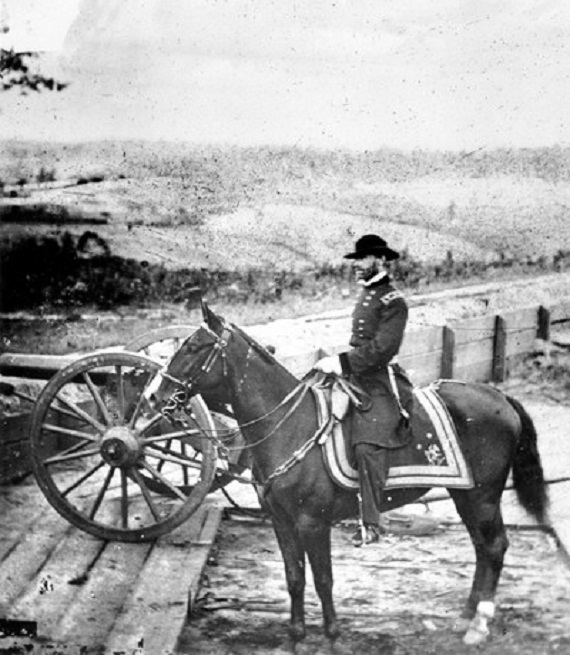The kind of military onslaught that Union Gen. William Sherman unleashed on the South, beginning with his infamous conquest of Atlanta and subsequent “March to the Sea,” followed by his capture of Savannah 150 years ago this month, came to be called, in the 20th century, “total war.”
That meant a war waged with full military mobilization not only against the enemy army but upon civilians in enemy territory and their property, stores and factories, with murder, looting, arson and assault from which neither women, children, the elderly or infirm were spared. It had never been seen before in the history of civilization, and it set a precedent for the all-out slaughters of the two world wars of the next century.
It didn’t happen by accident. Its germs were sown as early as March 1863, just three months after the Emancipation Proclamation, as the reason for the war for the first time gradually became the elimination of slavery and the military command, just as much as the troops on the ground, began to adopt a certain moral fervor, some of them with an outright John-Brown-like zealotry. In a letter to Gen. Ulysses Grant on March 31, General-in-Chief Henry Halleck said:
“The character of the war has very much changed. … There is now no possible hope of reconciliation with the rebels. … There can be no peace but that which is forced by the sword. We must conquer the rebels.”
>Grant replied: “Rebellion has assumed that shape now that it can only terminate by the complete subjugation of the South. It is our duty to weaken the enemy, by destroying their means of subsistence, withdrawing their means of cultivating the fields, and in every other way possible.”
Total war. Something very like what is now known as genocide.
Thus it was for Grant in Vicksburg, Sheridan in Virginia, and Sherman in Jackson (“The land is devastated for 30 miles around”) and Meridian (“no longer exists”). Then, in August, into Georgia (“I can make Georgia howl,” Sherman wrote), and finally Atlanta. He defeated a small Confederate force there, ordered the evacuation of the city, and burned most of it to the ground, leaving only 400 of some 4,000 private residences standing.
A month to recoup, then the march from Atlanta (“smoldering and in ruins,” Sherman said) across Georgia to Savannah. A march of plunder and pillage, 60,000 Union soldiers on a rampage for two months, looting and burning homes, shops and warehouses, setting fires across the plantations that grew to 60 miles wide at some points, confiscating all foodstuffs for Union use, leaving white and black near starvation. Sherman estimated that his army did $100 million worth of damage to the countryside (more than $1.5 billion today), destroying 300 miles of railroad, capturing or killing livestock, and leaving most of the state’s population of a million, black and white, destitute. “We are not only fighting armies,” Sherman said, “but a hostile people, and must make old and young, rich and poor, feel the hard hand of war.”
Savannah fell in December, practically without resistance: “I beg to present you, as a Christmas gift,” Sherman wired Lincoln, “the city of Savannah, with 150 heavy guns and plenty of ammunition, and also about 25,000 bales of cotton.” Instead of burning down his gift, he boarded his men for about a month and resupplied them from the Union ships that had blockaded the Savannah harbor and from empty plantations in the area. Sherman wrote to Halleck: “The truth is the whole army is burning with an insatiable desire to wreck vengeance upon South Carolina,” because of course it was the lead secessionist state.
The Carolina campaign, the march from the sea, was even fiercer than the Georgia one. A reporter for a Northern newspaper wrote: “As for wholesale burning, pillage, devastation, committed in South Carolina, magnify all I have said of Georgia fifty-fold, and then throw in an occasional murder.” There was little resistance, and the ruination was total: “The destruction of houses, barns, mills, etc. was almost universal,” a Union captain wrote, and a Sherman aide testified that “a majority of the Cities, towns, villages, and country houses have been burnt to the ground.” A Union major concluded, “Aside from the destruction of military things, there were destructions overwhelming … Day by day our legions of armed men surged over the land, over a region forty miles wide, burning everything we could not take away.”
After this fierce force swept through South Carolina, annihilating the hated center of Columbia in mid-February along the way (soldiers “infuriated, cursing, screaming, exulting in their work …the whole town was wrapped in one huge blaze”), it moved on to Florence on March 3 on its way north. A Union officer wrote, “The sufferings which the people here will have to undergo will be most intense. We have left on the wide strip of country we have passed over no provisions which will go any distance in supporting the people.”
On that same day, 350 miles north, Abraham Lincoln addressed a crowd from the steps of the Capitol after his second inauguration. He promised to continue the war “with malice toward none; with charity for all.”
With malice toward none.








One Comment